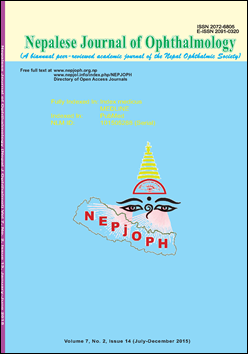Prevalence and Causes of Visual Impairment and Blindness in Three Ecological Regions of Nepal
DOI:
https://doi.org/10.3126/nepjoph.v13i1.29217Keywords:
Epidemiology, Public health, Optic, Refraction, VisualAbstract
Introduction: Visual impairment and blindness are significant public health issues worldwide. The objective of this study was to estimate the prevalence and causes of moderate to severe visual impairment (MSVI) and blindness in people aged 15 years and above across three ecological regions of Nepal.
Materials and methods: A comparative cross-sectional study was conducted in one district in each of the three ecological regions of Nepal. Number of participants from each region was distributed as per the prevalence findings of pilot study, with 2815 participants enrolled in Dolakha, 1509 in Dhading and 910 in Sarlahi. Intensive training was provided to health workers on how to conduct door-to-door enumeration, visual acuity testing and referral when indicated for comprehensive ocular examination by technicians and ophthalmologists to diagnose and treat ocular morbidities. Collected data were analyzed using standard software. For categorical data, frequency, percentage and 95% CI were calculated and statistical tests were done using Chi-square/Fisher exact test.
Results: Altogether 5234 participants were enrolled in the study (participation rate 96.4%). The overall prevalence of MSVI was 9.5% (495). It was 4.7% (133) in the mountainous region, 11.2% (169) in the Hill and 21.2% (193) in the Tarai. In those aged 15-49 years, MSVI prevalence was 1.5% (52) and 25.1% (433) in ≥50 years. The overall prevalence of blindness was 0.9% (47). It was 0.2% (6) in 15-49 and 2.3% (41) in ≥50 age groups. More than 95% visual impairment and blindness were due to cataract and uncorrected refractive error. Cataract was the leading cause of visual impairment and blindness (290, 53.5%), followed by uncorrected refractive error.
Conclusion: The prevalence of visual impairment and blindness varied significantly with age, ethnicity and locality. The management of uncorrected refractive error and operable cataract would reduce nine in ten cases of moderate to severe visual impairment and blindness.
Downloads
Downloads
Published
How to Cite
Issue
Section
License
This license enables reusers to copy and distribute the material in any medium or format in unadapted form only, for noncommercial purposes only, and only so long as attribution is given to the creator.




